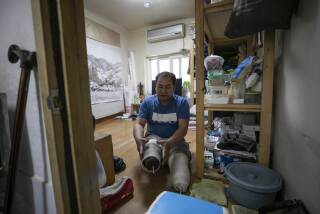Getting the Lead Out
Lead remains the most serious environmental threat for U.S. children.
Children ages 6 months to 6 years are at greatest risk of lead poisoning, which can slow a child’s growth and cause learning and behavior problems. Lead was outlawed in paint as of 1978, but older paint can crumble into dust that clings to toys, fingers and other things kids normally put in their mouths.
Even low levels of lead exposure can have an effect on a child’s IQ. Lead poisoning can also cause kidney damage and anemia, contribute to high blood pressure and affect the reproductive organs.
An estimated 890,000 children ages 1 to 5 have elevated levels of lead in their systems, according to the Centers for Disease Control and Prevention.
“The battle is far from over,” said Jerry Hershovitz, chief of the CDC’s lead poisoning prevention branch. “This is a disease that should not be in our society because we know what causes it and what it takes to prevent it, yet it’s still here.”
Who’s at risk?
* One in 12 Medicaid children in the United States, or about 500,000 children, have harmful levels of lead in the their blood, triple the rate of those not receiving Medicaid.
* California has about 2.2 million older homes which are likely to have lead paint, putting 2 million kids at risk for lead poisoning.
* An estimated 7.84% of 1- to 5-year-olds in California, or 239,000 kids, have elevated blood lead levels.
* In Los Angeles County, an estimated 50,000 kids are at risk of lead poisoning. Five lead “hot zones” have been identified in the San Fernando Valley based on poverty levels, age of housing and population of young children.
* Since 1991, there have been 3,943 confirmed cases of lead poisoning countywide, including 36 cases in the north San Fernando Valley and Santa Clarita Valley, 81 cases in the East San Fernando Valley, 55 cases in the West San Fernando Valley and 36 cases in the Glendale area.
Did You Know?
* Most children with lead poisoning don’t look or act sick?
* Pencils are not a threat because they contain graphite, not lead.
* When lead was taken out of gasoline, blood levels in the general population dropped dramactically.
* Bullets stuck in the flesh don’t pose a major lead risk, but bullets that remain in body cavities, such as the stomach or lungs, cna be absorbed and cause lead poisoning.
What you can do:
* Clean up paint chips and dust with a wet mop or cloth. Don’t scrape, sand, burn or sweep paint.
* Replace a lead-painted item (like a door) with a lead-free item; cover surfaces that can’t be replaced (like walls or floors) with a tough material like Sheetrock, paneling or floor tiles or remove the lead paint completely.
* If you choose to remove the lead paint, wear a respirator so you don’t breathe in lead. Children, pregnant women and pets shouldn’t be in house when work is done.
* Wash children’s hands and faces after playing outside or on the floor.
* A nutritious diet of regular meals can give some protection against lead absorbtion.
* Buy crayons only with “nontoxic” label
* Test household items using a lead test kit.
Lead Poisoning in Children
Number of reported cases of children 16 and under with elevated blood lead levels in L.A. County.
‘91: 88
‘94: 869
‘97: 424
How Lead Affects The Body
1. Lead enters person’s body when inhaled or ingested. Organic lead compounds, such as lead acetate in some pesticides, can be absorbed through the skin.
2. Lead goes into stomach where it is absorbed in the intestines and enters the blood.(Lead is absorbed more quickly in someone with an empty stomach.)
3. Once in the blood, lead can travel throughout the body, targeting the bone marrow, nervous system and kidneys. The half-life of lead in blood is approximately 30 days.
*
Lead can cause anemia by inhibiting several enzymes that are necessary to make healthy red blood cells.
*
Damage to the nervous system results in swelling of the brain, which in extreme cases can cause seizures, coma and even death.
*
Since it’s a similar composition to calcium, lead gets stored in the bones and is released over time in the blood. Lead in bones has a half-life of more than 20 years.
*
In extreme cases, lead poisoning can lead to renal failure.
*
Lead “Hot Zones” in the Valley
People living in these areas are at great risk for lead poisoning based on poverty level, age of housing and population of young children.
Where It’s Found
* Paint on houses built before 1960, especially walls and windowsills, and in dirt around these homes
* Ceramics, leaded crystal and pottery.
* Toys and imported cans that are sealed with lead solder.
* Some folk remedies and cosmetics
* Lead dust on work clothes.
* Dirt near freeways
* Some imported candy.
* Water that flows through some types of pipes and faucets
* Car batteries and radiators.
Child Lead Poisoning
Number of cases by age, 1991-1997*
Age 0-2: 2,311
Age 3-5: 1,286
Age 6-10: 291
Age: 11-16: 55
* Children 16 years of age and under; numer of cases: 3,943
***
Free blood testing is available fo children of low-income families. For more information, call the county’s Childhood Lead Poisoning Prevention Program at (800) LA4-LEAD,
Sources: Los Angeles County Department of Health Services, California State Department of Health Services, Environmental Protection Agency, American Gas Assn.; Researched by STEPHANIE STASSEL/Los Angeles Times
More to Read
Start your day right
Sign up for Essential California for news, features and recommendations from the L.A. Times and beyond in your inbox six days a week.
You may occasionally receive promotional content from the Los Angeles Times.






